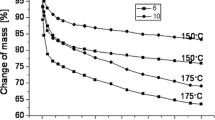Abstract
In this article the effect of variations in the fatty acid chain of oligofructose fatty acid esters (OFAE) on foamability and foam stability is described. First, oligofructose (OF) mono-esters containing saturated fatty acid chains ranging between C4 and C18 were studied. Additionally, a mono-ester containing a C16 mono-unsaturated fatty acid chain and a C12 di-ester were studied. Finally, to investigate the influence of the size of the hydrophilic group, commercially available sucrose esters were studied. The surface tension and surface rheological properties of air/water interfaces stabilized by the esters were determined, as well as the foaming properties of the esters, at a bulk concentration of 0.2 % (w/v). OF mono-esters with intermediate fatty acid chain lengths (C10-C16) were able to migrate quickly to the interface producing foams with small bubbles (0.4 mm), a relatively narrow bubble size distribution, and a high stability. For oligofructose mono-esters containing fatty acids C4 and C8, the bulk concentration of 0.2 % (w/v) was below the CMC, resulting in insufficient surface coverage, and low foamability and foam stability. The OF C18 mono-ester and the OF C12 di-ester were slow to migrate to the interface resulting in low foamability. Despite similar surface tension values, the foam half-life time of OFAE was higher than of the corresponding sucrose esters. OFAE gave higher surface dilatational moduli compared to sucrose esters. Based on the frequency dependence of the modulus and analysis of Lissajous plots, we propose that OFAE may be forming a soft glass at the interface.







Similar content being viewed by others
References
B.S. Murray, R. Ettelaie, Curr. Opin. Colloid Interface Sci. 9, 314–320 (2004)
D. Langevin, ChemPhysChem 9, 510–522 (2008)
P.J. Wilde, Curr. Opin. Colloid Interface Sci. 5, 176–181 (2000)
S. Hilgenfeldt, S.A. Koehler, H.A. Stone, Phys. Rev. Lett. 86, 4704 (2001)
S.A. Koehler, S. Hilgenfeldt, H.A. Stone, Langmuir 16, 6327–6341 (2000)
J.B. Bezelgues, S. Serieye, L. Crosset-Perrotin, M.E. Leser, Colloids Surf. A 331, 56–62 (2008)
M.A. Bos, T. Van Vliet, Adv. Colloid Interf. Sci. 91, 437–471 (2001)
L.K. Shrestha, Y. Matsumoto, K. Ihara, K. Aramaki, J. Oleo Sci. 57, 485–494 (2008)
P.A. Wierenga, H. Gruppen, Curr. Opin. Colloid Interface Sci. 15, 365–373 (2010)
P.A. Wierenga, L. van Norél, E.S. Basheva, Colloids Surf. A 344, 72–78 (2009)
S.E.H.J. Van Kempen, C.G. Boeriu, H.A. Schols, P. De Waard, E. Van der Linden, L.M.C. Sagis, Food Chem. 138, 1884–1891 (2013)
S.E.H.J. Van Kempen, K. Maas, H.A. Schols, E. Van der Linden, L.M.C. Sagis, Food Hydrocoll. 32, 162–171 (2013)
S.D.P. Eugénie, D. Fabrice, C. Gérard, M. Samir, Food Hydrocoll. (2012). doi:10.1016/j.foodhyd.2012.12.001
A. Ducret, A. Giroux, M. Trani, R. Lortie, J. Am, Oil Chem. Soc. 73, 109–113 (1996)
T. Zhang, R.E. Marchant, J. Colloid Interface Sci. 177, 419–426 (1996)
G. Garofalakis, B.S. Murray, D.B. Sarney, J. Colloid Interface Sci. 229, 391–398 (2000)
C.J. Drummond, D. Wells, Colloids Surf. A 141(131–142) (1998)
B.V. Zhmud, F. Tiberg, J. Kizling, Langmuir 16, 2557–2565 (2000)
J. Lucassen, M. Van Den Tempel, Chem. Eng. Sci. 27, 1283–1291 (1972)
P. Cicuta, E.J. Stancik, G.G. Fuller, Phys. Rev. Lett. 90, 236101/1–236101/4 (2003)
W. Drenckhan, D. Langevin, Curr. Opin. Colloid Interface Sci. 15, 341–358 (2010)
G. Garofalakis, B.S. Murray, Colloids Surf. B 21(3–17) (2001)
S. Soultani, S. Ognier, J.M. Engasser, M. Ghoul, Colloids Surf. A 227(35–44) (2003)
A. Mackie, P. Wilde, Adv. Colloid Interf. Sci. 117, 3–13 (2005)
Acknowledgments
This research forms part of the research program of the Dutch Polymer Institute DPI, project #687. The authors want to thank Carmen Boeriu for her contribution to the synthesis of the oligofructose fatty acid esters and Ricarda Enke for her contribution to the functional experiments. Finally, we thank Acatris for supplying the RYOTO sucrose esters.
Author information
Authors and Affiliations
Corresponding author
Rights and permissions
About this article
Cite this article
van Kempen, S.E.H.J., Schols, H.A., van der Linden, E. et al. Effect of Variations in the Fatty Acid Chain of Oligofructose Fatty Acid Esters on Their Foaming Functionality. Food Biophysics 9, 114–124 (2014). https://doi.org/10.1007/s11483-013-9324-1
Received:
Accepted:
Published:
Issue Date:
DOI: https://doi.org/10.1007/s11483-013-9324-1




